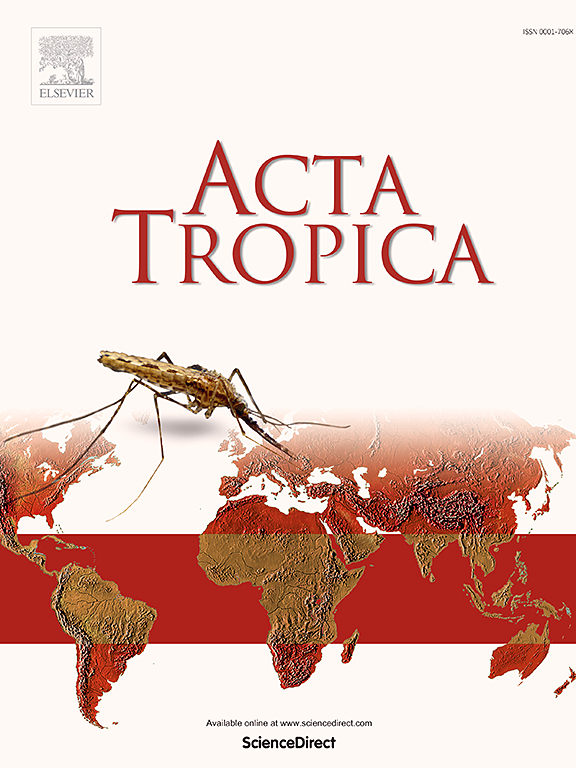Metabolic disruptions in P. vivax malaria: Insights from four antimalarial treatment regimens
IF 2.1
3区 医学
Q2 PARASITOLOGY
引用次数: 0
Abstract
Understanding how antimalarial regimens affect host metabolism could inform more effective Plasmodium vivax control strategies. This study investigated plasma metabolic alterations in P. vivax-infected patients treated with four antimalarial regimens using ultra-high-performance liquid chromatography-mass spectrometry. Patients received: (T1) chloroquine (CQ) for 3 days + primaquine (PQ) for 14 days; (T2) dihydroartemisinin-piperaquine (DHA-PPQ) for 3 days + PQ for 14 days; (T3) CQ + PQ42 (from day 42); or (T4) DHA-PPQ + PQ42 (from day 42). CQ-based regimens (T1, T3) caused broad metabolic perturbations involving arginine/proline, aspartate/asparagine, glutamate, nitrogen, pyrimidine, and vitamin B3 metabolism pathway. TI specifically affected alanine/aspartate, and methionine/cysteine metabolisms, while T3 influenced aminosugar, butanoate, glutathione metabolisms, glycine, serine, alanine, threonine metabolisms, tyrosine, and ubiquinone metabolisms. These disruptions have the potential to impair vascular function and immune responses, and affect redox balance and energy production, vital in parasite clearance and host recovery. Contrastingly, DHA-PPQ-based regimens (T2, T4) had distinct effects. T2 altered histidine metabolism, while T4 disrupted the carnitine shuttle, porphyrin metabolism, and plasma lipid levels; changes that may potentially impact energy homeostasis during infection, hemoglobin turnover and oxidative stress responses. Regimens lacking PQ (T3, T4) affected androgen/estrogen biosynthesis, implicating PQ to modulate hormone-related responses during treatment. These findings suggest antimalarial regimens exert regimen-specific metabolic effects, with CQ-based therapies broadly impacting amino acid and redox metabolism, and DHA-PPQ-based therapies affecting lipid and mitochondrial pathways. Mapping these metabolic signatures reveals the profound impact of these interventions on patients and support host-directed strategies for optimized vivax malaria management.
间日疟原虫疟疾的代谢紊乱:来自四种抗疟疾治疗方案的见解。
了解抗疟方案如何影响宿主代谢可以为更有效的间日疟原虫控制策略提供信息。本研究利用超高效液相色谱-质谱法研究了间日疟原虫感染患者接受四种抗疟方案治疗后的血浆代谢变化。患者接受:(T1)氯喹(CQ) 3天 + 伯氨喹(PQ) 14天;(T2)双氢青蒿素-哌喹(DHA-PPQ)治疗3天 + PQ治疗14天;(T3) CQ + PQ42(从第42天开始);或(T4) DHA-PPQ + PQ42(从第42天开始)。以cq为基础的方案(T1, T3)引起广泛的代谢紊乱,涉及精氨酸/脯氨酸、天冬氨酸/天冬氨酸、谷氨酸、氮、嘧啶和维生素B3代谢途径。TI特别影响丙氨酸/天冬氨酸和蛋氨酸/半胱氨酸代谢,而T3影响氨基糖、丁酸盐、谷胱甘肽代谢、甘氨酸、丝氨酸、丙氨酸、苏氨酸代谢、酪氨酸和泛素代谢。这些破坏有可能损害血管功能和免疫反应,并影响氧化还原平衡和能量产生,这对寄生虫清除和宿主恢复至关重要。相比之下,以dha - ppq为基础的方案(T2, T4)具有明显的效果。T2改变组氨酸代谢,而T4破坏肉碱穿梭、卟啉代谢和血脂水平;在感染、血红蛋白转换和氧化应激反应过程中可能潜在影响能量稳态的变化。缺乏PQ (T3, T4)的方案影响雄激素/雌激素的生物合成,暗示PQ在治疗期间调节激素相关反应。这些发现表明,抗疟方案发挥方案特异性代谢作用,以cq为基础的治疗广泛影响氨基酸和氧化还原代谢,而以dha - ppq为基础的治疗影响脂质和线粒体途径。绘制这些代谢特征揭示了这些干预措施对患者的深远影响,并支持以宿主为导向的优化间日疟疾管理策略。
本文章由计算机程序翻译,如有差异,请以英文原文为准。
求助全文
约1分钟内获得全文
求助全文
来源期刊

Acta tropica
医学-寄生虫学
CiteScore
5.40
自引率
11.10%
发文量
383
审稿时长
37 days
期刊介绍:
Acta Tropica, is an international journal on infectious diseases that covers public health sciences and biomedical research with particular emphasis on topics relevant to human and animal health in the tropics and the subtropics.
 求助内容:
求助内容: 应助结果提醒方式:
应助结果提醒方式:


